 Chinese Deep Ice Core drilling in Dome A Antarctica
Chinese Deep Ice Core drilling in Dome A Antarctica
 Plateau mountain glacier drilling
Plateau mountain glacier drilling
 BAS
BAS
 EGRIP in Greenland Arctic
EGRIP in Greenland Arctic
 Neumayer
Neumayer
 Antarctic ice shelf hot water drilling and subglacial sediment sampling drilling
Antarctic ice shelf hot water drilling and subglacial sediment sampling drilling
 Test drilling project of Pollution-free drilling and sampling equipment for Antarctic subglacial lake
Test drilling project of Pollution-free drilling and sampling equipment for Antarctic subglacial lake
 Antarctic blue ice airport site survey
Antarctic blue ice airport site survey
 Chinese Subglaical bedrock drilling in Antarctica
Chinese Subglaical bedrock drilling in Antarctica

The biggest ice stream in Greenland 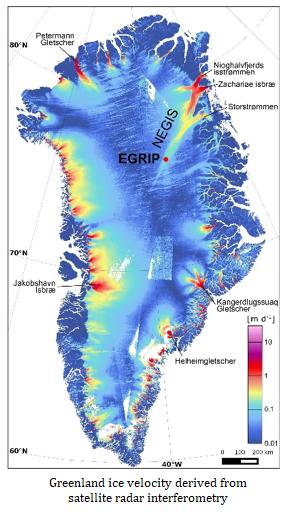 is Northeast Greenland Ice Stream (NEGIS). It begins right at the central ice divide and cuts through the ice sheet approximately 1000 km downstream in a wedge shape to feed into the ocean through three large ice streams. The onset of the ice stream on the ice divide is believed to be caused by strong melting at the base. The recent step of researches is focused on the deep drilling activity that allow to study the dynamics of the ice flow in an ice stream by ice rheology and deformation studies of the ice core and by borehole observations of basal sliding, borehole deformation, and basal water processes.
is Northeast Greenland Ice Stream (NEGIS). It begins right at the central ice divide and cuts through the ice sheet approximately 1000 km downstream in a wedge shape to feed into the ocean through three large ice streams. The onset of the ice stream on the ice divide is believed to be caused by strong melting at the base. The recent step of researches is focused on the deep drilling activity that allow to study the dynamics of the ice flow in an ice stream by ice rheology and deformation studies of the ice core and by borehole observations of basal sliding, borehole deformation, and basal water processes.
In 2012 the international consortium was established to support East Greenland Ice drilling Project (EGRIP or EastGRIP), both financially and logistically. At present, national funding agencies in Denmark, Germany, Japan, Norway, China and the U.S. have sponsored the project that is planned for the years 2016 to 2020. The position of the drilling site was chosen at the upper part of the ice stream at the point 75.63° N, 35.99° W, 2708 m a.s.l approximately 200 km apart from the ice divide far enough away from the margin to be free from crevasses for safe surface operations.
The surface velocity at the site is 65 m/yr to the northeast corresponding to that the drill hole will move sideways along with the ice by about 180 mm (more the one hole diameter!) every day. The ice thickness at the drill site is near 2550 m.
The field participants, food, fuel, drilling fluid, scientific equipment deploy to EGRIP from Kangerlussuaq, settlement on the west coast of Greenland, 50 km to the north from the Arctic Circle. The route from Kangerlussuaq to EGRIP camp, approximately 1000 km is accomplished with LC-130 Hercules aircraft with wheel-ski gear operated by 109th Airlift Wing of US Air Force.
EGRIP camp was built up during summer season 2016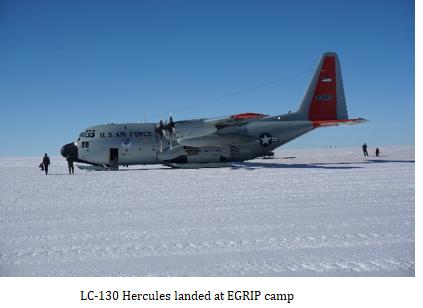 as a fully operational deep drilling site with ice core storage facilities, science trench, drill trench, workshops, garage, warm laboratories and housing for normally 24 (max 52) people. The ball-shaped main dome is divided into two floors: downstairs – kitchen, dining room, shower room, WC, washroom; upstairs – rest area, several computer stations, office of the field leader and few bunk beds. Several weatherports serving as living tents for staff are placed nearby.
as a fully operational deep drilling site with ice core storage facilities, science trench, drill trench, workshops, garage, warm laboratories and housing for normally 24 (max 52) people. The ball-shaped main dome is divided into two floors: downstairs – kitchen, dining room, shower room, WC, washroom; upstairs – rest area, several computer stations, office of the field leader and few bunk beds. Several weatherports serving as living tents for staff are placed nearby.
The main science and drilling facilities are located under snow in two connected tunnels which are referred to as science trench and drill trench. In season 2016 the main drilling equipment was installed and pilot hole had been drilled for casing installation to isolate the permeable near 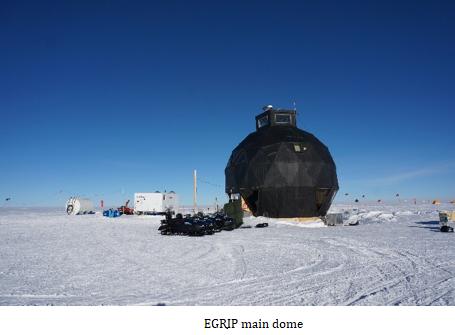 surface snow–firn formation. The Hans Tausen (HT) electromechanical drill has been mounted on the shallow drill tower and drilling of the first core sections of the deep EGRIP ice core was done on July 16, 2016. The HT drill was designed in University of Copenhagen, Denmark and named after Hans Tausen Ice Cap, Greenland where it was firstly tested in 1995.
surface snow–firn formation. The Hans Tausen (HT) electromechanical drill has been mounted on the shallow drill tower and drilling of the first core sections of the deep EGRIP ice core was done on July 16, 2016. The HT drill was designed in University of Copenhagen, Denmark and named after Hans Tausen Ice Cap, Greenland where it was firstly tested in 1995.
The drill can work in either dry or liquid-filled holes and consists of core barrel, chips chamber, pressure tight section, anti-torque section and cable termination. It has a double type core barrel with three-cutters drill head. Ice chips are transported through the space between the core barrel and the outer jacket by three spiral flights fixed to the core barrel.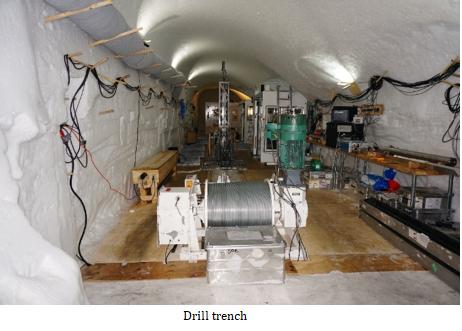
The ‘dry’ pilot hole was drilled to the depth of 108.73 m with a diameter of 129.6 mm (density measurements showed that close off depth is at 62 m). Then few times the hole was reamed in order to accommodate bulky fiberglass tubes with pin and box ends held together by a steel wire and sealed with an O-ring.
In season 2017, the drill trench was completed by installing the deep drill tower and the deep drill winch. The reaming was continued and finally casing was installed. Then the hole was filled partially with drilling fluid composed of ESTISOLÔ 240 and COASOLÔ and drilling was continued by HT drill with near-bottom circulation. In spite on problems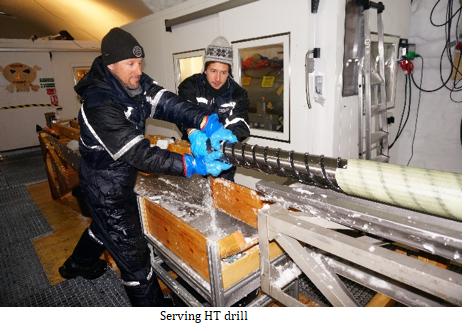
with electronics, borehole inclination, the hole reached 893.18 m by the end of the season.
In June 2017, P.G. Talalay, director of PRC, visited EGRIP camp and made agreements with Prof. D. Dahl-Jensen, leader of Centre for Ice and Climate (University of Copenhagen) about future cooperation within EGRIP project. To learn more about EGRIP project visit http://eastgrip.org/
Prof. P.G. Talalay and S. Hansen, lead drilling engineer of Center for Ice and Climate, at NEEM camp, June 2017
The Institute for Polar Science and Engineering of Jilin University has sent a total of 7 people in 4 times to participate in the "East Greenland Deep Ice Core Project" organized by the Copenhagen University, Denmark, as the main drilling technical force on site, JLU members complete the deep ice core drilling over 700 m, and drill through the Greenland ice sheet, obtained the ice sheet bottom basal ice and till and rock samples. This international cooperation project has also created a new model for Jilin university to carry out international joint exploration and technical cooperation in Polar regions.

Academician Prof. Sun Youhong and Prof. Pavel Talalay at the drilling site in Greenland

JLU staff participating in deep ice core drilling
Copyright © 2019 Jilin University